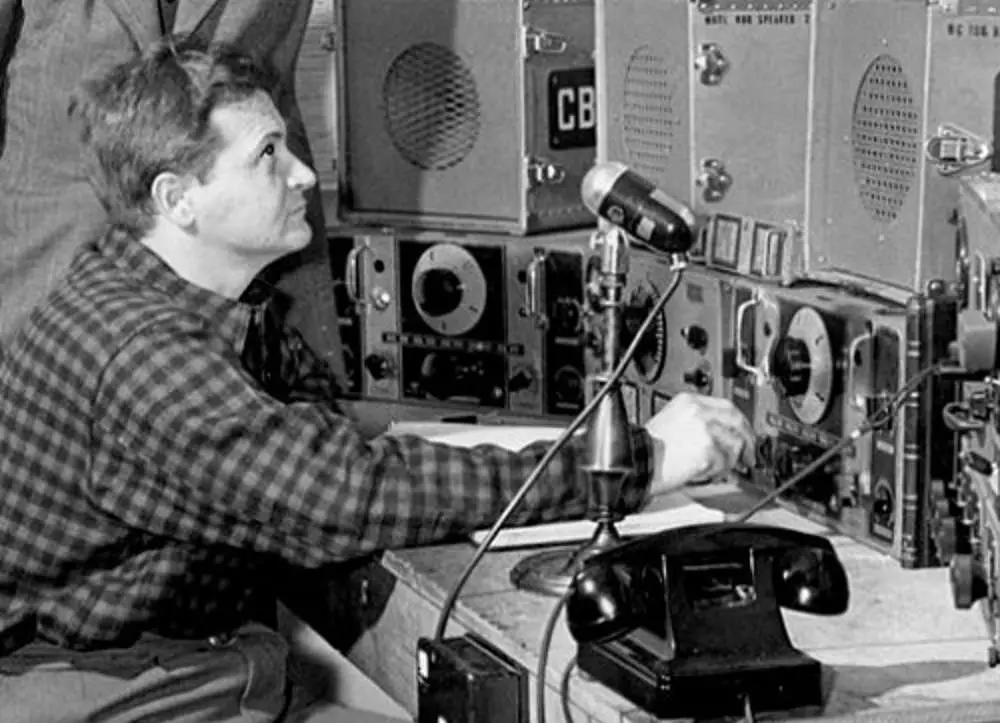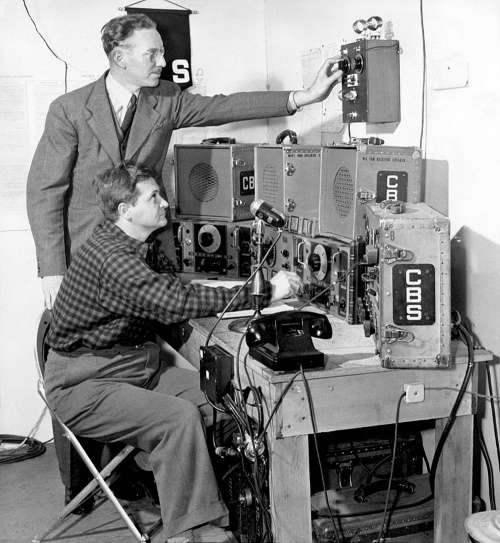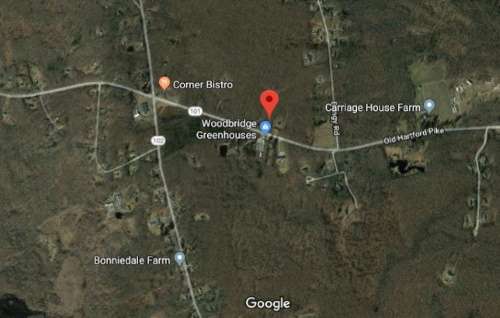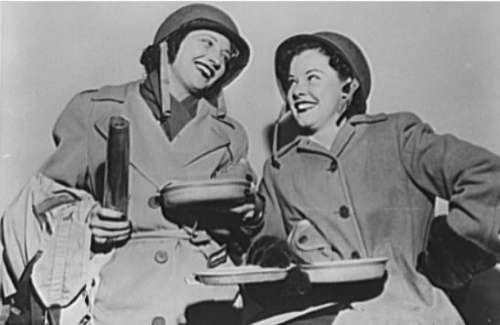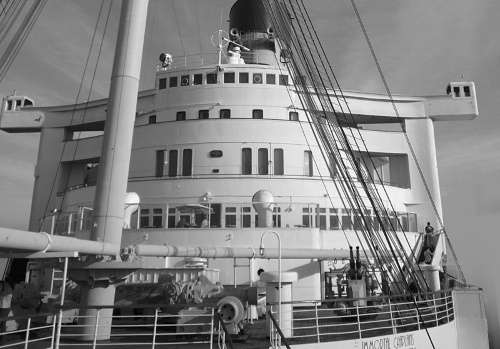Just before Pearl Harbor, Chopmist Hill in Scituate, R.I., was the center of the world. That’s what the Federal Communications Commission discovered in 1941. The hill’s geographic and atmospheric conditions were extremely favorable for radio reception, and its receivers could grab wireless signals from much of the globe.
With America on the verge of joining a global war, this was good news, especially for the FCC’s hardworking Radio Intelligence Division (RID). Chopmist Hill would become the most productive listening post for the men of this little-known civilian agency. Their work helped clinch victory for the United States and her allies.
The Radio Intelligence Division worked out of large, but hidden, radio listening posts – not only on Chopmist Hill but along the east and west coasts. These patrolmen of the ether prevented German intelligence from establishing a single wireless connection in the United States. They also discouraged Japanese agents from setting up U.S. radio links. They knew the FCC would nab them as soon as they went on the air, according to the Radio Intelligence Division’s director, George Sterling.
The Radio Intelligence Division also guided more than 600 lost airplanes to safety. They intercepted enemy agents’ secret transmissions to their bases and submarines. They even discovered a secret German weather station in Greenland, enabling the US Coast Guard to destroy it. Amazingly, from stateside, RID aided Philippine guerrilla operations.
And in the end, a Radio Intelligence Division outpost spent 37 hours establishing communications between the Japanese command and Gen. Douglas MacArthur. That set the stage for the Japanese surrender aboard the USS Missouri.
Chopmist Hill Gets Ears
Chopmist Hill first came to the FCC’s attention before the United State entered the war. Thomas B. Cave, an RID technician, had to find the best spot for a listening post to detect illegal private and commercial radio transmissions.
Cave had already settled on a spot in Greenville, R.I., when he discovered Chopmist Hill in Scituate. He found conditions there strangely ideal for receiving radio traffic from a large portion of the globe. Beyond its value for simple rule enforcement, Chopmist Hill served as the perfect global listening post as war loomed. Cave moved his operations there in March 1941.
Cave had discovered a quirk of nature up on 731-foot-tall Chopmist Hill. Line-of-sight mobile communications and low-frequency signals meant to travel just a few hundred miles bounced off the atmosphere and straight down to Chopmist Hill.
But setting up a top-secret listening post was no small matter.
Cave leased a 14-room farmhouse surrounded by 183 acres for his 40-member team. Fences and armed guards bordered the complex, which had its own blockhouse, barracks and generator. No one could approach or enter without a state police escort.
Like the 11 other primary listening posts, Chopmist Hill had state-of-the-art receiving and recording equipment manned by highly trained operators.
Outdoors, the station bristled with poles and wires, more than 16 miles of them. It had rhombic antennas, wires strung on poles in the shape of a rhombus, or diamond. And it had four-pronged Adcock radio direction finders, which rotated to get a geographical fix on the source of a shortwave signal.
Nine Feet Under
The poles, set nine feet in the ground, didn’t poke up above the tree line and attract attention.
To improve reception, Cave called the local utility company, Narragansett Electric, to send out foreman Charlie Weinert to move the antenna poles. Sometimes a pole had to move just a few feet. Cave later said, “Weinert thought I was clean crazy.”
So effective was the secrecy on Chopmist Hill that the listening post’s very existence was revealed to the public only after the end of hostilities.
But when the government finally declassified the station, Cave told Weinert, “Every time you moved those poles you were following Rommel as he was backing up across North Africa.”
Weinert reportedly shot back, “Why, if I had known that, I’d have dug poles all the way to Cairo.”
Chopmist, Up and Running
Cave claimed Chopmist Hill could zero in on the location of any radio transmission within 15 minutes. Skeptical army brass tested Cave’s assertions, secretly setting up an impromptu station and transmitting a signal. It took Cave and his crew seven minutes to notice the signal and identify its source as the Pentagon.
The Chopmist Hill post could receive radio transmissions from Europe, Africa, the Caribbean, and South America. Cave later said it could even pick up tank-to-tank transmissions from German Field Marshal Erwin Rommel’s Afrika Corps in North Africa. Chopmist Hill forwarded those messages to the British commander in the area, Gen. Bernard Montgomery.
RID chief George Sterling later said he often wondered if everyone at Chopmist Hill would get home safely.
“If the enemy had known how we were recording messages sent between agents right in Germany, they would have eliminated the Scituate Station and everyone in it, provided they could.”
The Airwave Harvest
At Chopmist and elsewhere, much of what the RID intercepted was encrypted or in non-English languages. These messages were recorded and forwarded to the Signal Security Agency in Washington, D.C., for deciphering or translation. How some transmissions got deciphered—specifically, messages encrypted with Nazi Germany’s top-secret Enigma code—remains a mystery.
“Was there a twin Ultra machine [British military intelligence’s ultra-secret decryption computer] in Washington to which Scituate fed…?” asks Paul Eno, author of the 2005 book Rhode Island: A Genial History. “If not, how were secret interceptions in the secret German code translated?” The answer may have to wait until declassification of the RID’s wartime files in 2049.
One of the seemingly mundane tasks assigned to the Chopmist Hill unit was to home in on German weather reports from Central Europe. Chopmist forwarded them to the British bomber command. Once the United States joined the war, it sent them to U.S. Army Air Forces commands based in England. The reports were essential for planning air raids over Axis targets.
Ferreting Out Spies
One of Chopmist Hill’s tasks was to find radio spies. The problem of espionage had become apparent in Central and Latin America as early as 1940. That October, the RID station in Tampa, Florida, picked up maritime radio signals and narrowed them down to small vessels of the Gough Brothers line, operating out of British Honduras. Further investigation suggested these vessels were carrying fuel to German U-boats in the Gulf of Mexico and passing information to them.
A sting operation snared a total of 20 men, including principal owner George Gough. But the persistent problem of Axis espionage in Latin America led the FCC to help ferret out radio spies.
The FCC then sent some of its top monitoring officers south of the border. They succeeded everywhere except Argentina, officially neutral in the war. Spies pushed out of other South American countries found a safe base in Argentina, where even commercial radio transmitters were sending vital information to Axis Japan, Italy and Germany. The RID men tried to shut down enemy radio transmissions there, but the Argentine government became so hostile that the FCC withdrew the agents for their own safety.
Chopmist Hill To The Rescue
In addition to spying and counterspying, Chopmist Hill saved Allied lives.
Once, when a USO plane carrying American actress Kay Francis got lost, the Chopmist Hill listening post came to the rescue. It picked up the pilot’s radio transmissions, pinpointed his location and guided him to safety.
The station also saved many American lives aboard the British ocean liner Queen Mary. She then ferried U.S. troops to fight in Europe. While the ship docked in Rio de Janeiro for fuel and supplies in March 1942, local German spies somehow learned her future course and alerted their superiors. Fortunately, operators on Chopmist Hill intercepted the message. The Queen Mary’s captain changed course, avoiding the wolf pack of German U-boats lying in wait and saving the lives of some 14,000 GIs on board.
On yet another occasion, a place carrying wounded men home to the States from Europe crash-landed in Canada’s far-northern Labrador province, so close to the magnetic North Pole that getting an accurate fix on the plane’s exact location was difficult. But the Chopmist Hill team did it, and rescue operations got underway. Even then it took three months to get all the plane’s passengers to safety.
Listening to Japan
Chopmist managed to pick up Japanese radio traffic before the December 1941 raid on Pearl Harbor, according to RID chief George Sterling.
The Rhode Island site also detected signals from radio transmitters on incendiary balloon bombs the Japanese had launched into the jet stream to float across the Pacific and explode in America and Canada.
Each bomb-laden, hydrogen-filled balloon emitted a tracking signal so the Japanese could follow its progress. The Chopmist Hill listeners forwarded balloons’ locations to West Coast fighter squadrons, which attempted to intercept and shoot down the floating bombs before they did any harm.
Most of the fighters’ efforts were in vain. They managed to shoot down less than 20 of the more than 9,000 launched. Fortunately, few of the balloons that reached inland North America exploded. One did kill a pregnant woman and five children on a Sunday school outing in Oregon.
Chopmist Hill Revealed
Soon after the war, the FCC gave Thomas Cave permission to grant an interview to the Providence Journal. He could reveal the Chopmist Hill station’s existence, its purpose and some of its wartime successes.
The FCC maintained a station there until 1950 with a skeleton crew to fulfill the original purpose of catching unlicensed radio transmitters. Rhode Island’s Civil Preparedness Division then took over the facility as its headquarters.
In 1965 the hilltop site reverted into private hands. One Frederick Leeder purchased it at auction in 1968; by then, a scant five acres of the original 183 remained. As Leeder learned about the property’s history, he and others tried in vain to get the site listed on the National Register of Historic Places. However, the FCC equipment had been removed, so the site did not meet the criterion of substantial conformity to how it looked during its period of historic activity.
Why isn’t Chopmist Hill spiked with surveillance antennas today? The answer is simple: change. The rural, backcountry location has grown immensely since 1945. Houses, factories and other buildings interfere with radio reception. The feats performed there in the past cannot be replicated.
In an interview shortly before his death, Cave told Eno, “It was not the receptivity of the location, but the advanced secret radio equipment used there that made Chopmist Hill’s place in history.” He added, “Though reception was remarkably good, it was 99 percent knowhow that created such a success between 1941 and 1945.”
Maybe. In 2049, perhaps we’ll know the whole story of Chopmist Hill, the FCC’s Radio Intelligence Division and their role in winning World War II.
The Radio Intelligence Division by the Numbers
To intercept enemy transmissions and prevent America’s airwaves from leaking secrets to the enemy, the agency eventually established 12 primary monitoring stations, 60 substations, and 90 mobile units in the U.S., Alaska, Hawaii, and Puerto Rico. At its peak, the Radio Intelligence Division employed 893 people.
The RID had mobile units, too—automobiles crammed with radio equipment,. Each had a surveillance man at its controls. These could follow up on a received signal, getting closer to pinpoint its source. The units relied on single-loop antennas, simple receivers based on a circle of wire or other conductive material.
For even closer investigation, the agency developed a handheld unit called the Snifter. This device was so sensitive that a radioman could detect not just the building but the room from which a signal was emanating.
On average, the radio intelligence men pinpointed, or fixed, more than 800 locations each month. It was quite an accomplishment, considering that each fix required operators to collect 6,000 bearings. But the intensive effort paid off.
Images: Queen Mary By derivative work: Altair78 (talk)Queen Mary forecastle.jpg: :Altair78 – Queen Mary forecastle.jpg, CC BY-SA 2.0, https://commons.wikimedia.org/w/index.php?curid=5144133.
This story was updated in 2023.
Leo Caisse, the author of this story, passed away in 2020. He published the book, The Civilian Conservation Corps: A Guide to Their Works in Rhode Island. He has also published a number of historical articles, including Ears On the World in America in World War II Magazine, October, 2017. Leo earned a B.A. and M.A. in American History from Providence College and he lived in East Providence, R.I.
